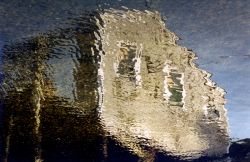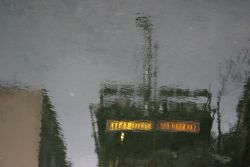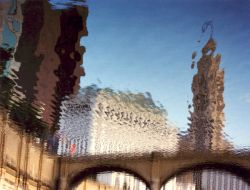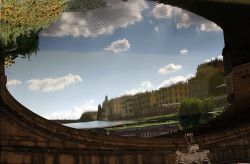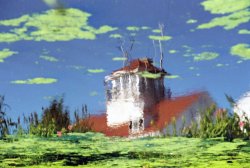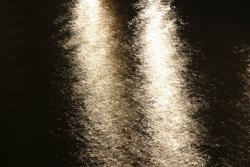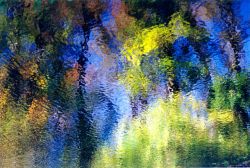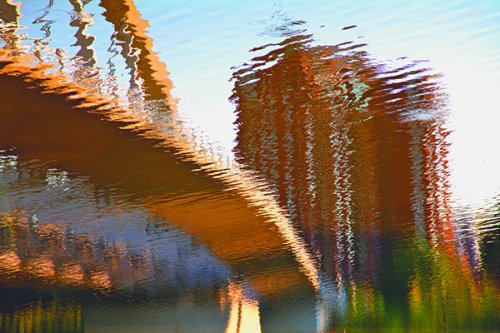The extraordinary Synesthesia: Art and the Mind
exhibition at the McMaster Museum of Art highlights artists who are
known synesthetes (David Hockney, Joan Mitchell, Marcia Smilack, and
Carol Steen) and works by artists thought to be synesthetic (including
Charles Burchfield, Tom Thomson, Wassily Kandinsky, and Vincent van
Gogh). Presented in one room, with each artist’s contributions grouped
together, the exhibit both allows a visitor to focus on the unique
attributes of each artist and to see the overlapping dynamics among
them. Had the exhibition merely provided a rare opportunity to explore
the high-quality work synesthetic artists, it would have made a
tremendous contribution.
Fortunately, the co-curators, Carol Steen and
Greta Berman, went one step further and incorporated the historical
research of Heinrich Klüver’s (1897-1979) on “Form Constants” and
reproductions of artwork by several early twentieth century synesthetic
artists studied by another scientist, Georg Anschütz (1886 -1953). In
addition, and much to the credit of all involved, a catalog featuring
six scholars and several color reproductions accompanies the exhibition.
This book make Synesthesia: Art and the Mind available to those unable to attend and will provide historical documentation for later generations.
Synesthesia is an involuntary joining of senses in which the real
information of one sense is accompanied by a perception in another
sense. Older views that this form of perception was either abnormal or
metaphoric have been replaced with a growing understanding that, while
idiosyncratic, the synesthetic experience is quite real and more
pervasive than formerly thought.
Research that has confirmed the reality
of synesthesia has also led to a re-evaluation of the symbolic,
metaphoric and associative approaches to art that have long aimed at
weaving the rich and resonant relationship among the senses together.e.g., an opera or a
ballet, etc.). What this means is that synesthetes have a life-long,
seemingly automatic ability to combine sensory experiences that
accompanies all aspects of their lives. More specifically, we now know that the experiences of genuine, genetic
synesthetes are qualitatively different from the type of cross-modal
intensification we have when engaged with an approach to art that is
intended to stimulate multiple senses (
Research has confirmed these
combinations (e.g., color and sound, colors and letters, etc.)
and found that they are both involuntary and consistent over time. We
also know that about 5% of the population has one of approximately 54
kinds of synesthesia and that creative people are more likely to be
synesthetes (or at least to acknowledge their synesthesia).
Since cross-modality has many associations with art historically, the Synesthesia: Art and the Mind
exhibition offers a priceless opportunity to think about what artists
with synesthesia add to our understanding of art per se, how the brain
of an artist with synesthesia differs from that of a non-synesthete (and
from the brain of individuals of the general population), and how our
individual endowments are harnessed in creative pursuits. While this
review can hardly cover the impact of the McMaster show on my thinking, I
will attempt to capture its essence in some overly abbreviated thoughts
on the exhibition and the themes that accompanied it.
First, I was quite impressed by the display as a symphonic whole. For example, Carol Steen’s Runs off in Front, Gold,
2003, although off to the side of the entrance, was the first piece I
noticed upon entering the room. Somehow, its powerful statement
immediately brought out the quality of all of the work on display.
One
of the curators of this exhibition, Steen has had a major role in
bringing synesthetes together, educating the public about the reality of
the synesthetic experience, and highlighting how synesthesia can aid an
artist in capturing the ineffable. Steen is a visual artist who paints
the brilliantly colored images she sees when she listens to music. [Some
of it is available at http://www.synesthesia.info/slides/.]
Although
her abstract pieces are expressive and essentially indescribable,
suffice it to say that there is a freshness, fluidity, and musicality to
Steen’s work; she has said that she To oversimplify, the layering and
rhythm of the paint had an energy that is reminiscent of aspects of the
work of Jackson Pollack and Mark Rothko, who were not synesthetes, but
are known for the way their paintings often trigger complex sensory and
perceptual experiences for the viewer. What really stayed in my mind as I
observed Steen’s art, and what I wish I could convey in this review, is
how the strength of her work is simply lost in web reproductions and
publications.
The
placement of Steen’s artwork nicely played off of the abstractions in
Joan Mitchell’s paintings on the one side and the more figurative work
of the Canadian painter Tom Thompson on the other. The Runs off in Front, GoldBrown Bushes, Late Autumn (1914), a small oil on wood from the National Gallery of Canada
collection that has similar colors and energy. A largely self-taught
artist who began to paint seriously in his thirties, Thomson’s
figurative work contains a tension between abstraction and landscape
that also brings to mind Cézanne’s late paintings and watercolors, which
often dissolve into color geometries. In terms of synesthesia, there
was an uncanny resemblance between the Steen abstractions and the more
representational Thomson, who also brought to mind the way van Gogh’s
strokes added expressive elements to a figure or scene.
This reference
to van Gogh is not an arbitrary one as it is said that van Gogh maddened
his music teacher by stubbornly testing his ideas on tone-color
correspondences during piano lessons. This remark (and others) has led
some to say that van Gogh was a synesthete. To highlight the connection
between a van Gogh and synesthesia, a van Gogh from the McMaster
collection was included in the show next to the Thomson piece. piece,
for example, had an extremely close resonance with Tom Thomson’s
Second,
because each artist had several pieces grouped together, except van
Gogh who was represented with only one painting, the display permitted
the pieces to echo one another and allowed the viewer to easily see the
style and personality of each individual artist. I particularly
appreciated this arrangement when looking at Marcia Smilack’s five
pieces. Smilack, who calls herself a “Reflectionist,” photographs
reflections on water as she hears them. The tantalizing results have a
painterly quality that is unlike the work of any other artist I know.
Writing about one piece, “Kandinsky-ish,” Smilack says:
“I
watched the reflection on water until the pink turned to satin against
my skin. As I watched the concentric circles dilating as they formed and
reformed, I soon felt myself become one with the motion. Free of
thought, I felt myself become what I was looking at and clicked the
shutter. A few days later, I was in a store looking for an art postcard
when I came upon one that startled me and gave me a jolt of excitement,
for the painting looked just like my new image (to me).
I can only say
that my sensation of recognition was unmistakable and unshakeable and
remains so to this day. When I turned it over to find out who had
painted the image, I discovered it was Wassily Kandinsky. The painting
was “Squares with Concentric Circles.” My only question, then and now,
was whether Kandinsky had the same form of synesthesia that I have.”
Smilack’s
works were hung next to the three Kandinsky’s in the show and I was
drawn to the way the abstractness of his work seems more formally
developed than Smilack’s repertoire. Indeed, what I find most appealing
about Smilack’s work is her ability to mix abstraction with
representation and fluidity with form.
Thinking about her results,
(viewable at marciasmilack.com/),I am tempted to say that the
photo-paintings are so sensitively seasoned that they just taste right,
although I am not a synesthete. What my comment means is that the work
has the flavor of a properly prepared gourmet dish comprised of
ingredients that one might not be able to identify precisely, but whose
combination one will never forget.
Ironically, the painterly quality of
Smilack’s photographs brings David Hockney’s photocollages to mind
because the “look” of his photographs is painterly more than
photographic. The irony here is that three of Hockney’s pieces are also
on display at the museum. These pieces are representative of how he
created opera sets, using his synesthesic color/sounds to inform his
artwork.
Finally,
in sitting down to write this review, I found my enthusiasm for the
artwork was boundless and yet my “reviewer’s mind” kept returning to
some of the critical ideas that accompanied the show’s presentation,
Heinrich Klüver’s ideas about Form Constants in particular. At the risk
of trying to say too much in a limited space, I will nonetheless offer a
few thoughts on the historical ideas that were brought into the show.
Briefly,
early in the twentieth century, Klüver, a scientist, systematically
studied the effects of mescaline (peyote) on the subjective experiences
of its users. His investigations showed that the drug produced
hallucinations characterized by bright, highly saturated colors and
vivid imagery. In addition, Klüver found that mescaline produced
recurring geometric patterns in different users. He called these
patterns 'form constants' and categorized four types: lattices
(including honeycombs, checkerboards, and triangles), cobwebs, tunnels,
and spirals.
This work also pointed to what is now called a “geometry of
the mind” and is common to synesthesia, illusions, hallucinations,
migraine auras, ordinary perceptions, and can be seen in primitive art.
Richard Cytowic, a neuroscientist who studies synesthesia, has said that
Klüver showed that a limited number of perceptual frameworks appear to
be built into the nervous system and that these are probably part of our
genetic endowment.
Klüver’s
work with Form Constants was expanded in the 1970s by Jack Cowan and
others, who recognized that the kind of experience Klüver studied is not
just a trait we can associate with hallucinogenic experiences, but is
in fact a general property of brain structure, more specifically the
region known as the primary visual cortex or V1. Since many of the
recent studies I am acquainted with that look at color hearing seem to
use spoken words in testing subjects, and stress relationships between
colored hearing and cortical area V4, the introduction of form constants
in connection with synesthesia raised several (hard to articulate)
questions in my mind. A short review can hardly address my musings.
The
case a Jonathan I., the color-blind artist studied by Oliver Sacks and
others is among the few reported cases on individuals who have lost
their ability to see color but retain their ability to see form and
movement. What makes him relevant here is that he was both a painter and
a synesthete. Briefly, Jonathan I. lost his ability to see and even
imagine colors after a minor car accident. He also lost his
color-hearing synesthesia after his accident. Oliver Sacks’ diagnosis
was that Jonathan I. had cerebral achromatopsia, a loss of color
sensation throughout his entire visual field caused by damage to the
cerebral cortex.
Ronald Hoffman’s Visual Intelligence notes that
Louis Verrey 1854-1916, a Swiss ophthalmologist, discussed a patient
with a similar kind of neurological event in 1888. Verrey’s clinical and
postmortem observations of his patient found damage to the most
inferior part of the occipital lobe, in the lingual and fusiform gyri,
which are located near the primary visual area, V1.
Although no reliable
anatomical information is available on Jonathan I., John Harrison has
written (2001) that it is assumed Jonathan I., too, suffered damage to
the lingual and fusiform gyri of the brain. The larger point here is
that when Mr. I. his lost his ability to see color, he also lost his
color hearing synesthesia.
When
Verrey made his proposal, at the end of the 19th century, his
conclusions were hotly contested. Hoffman’s discussion points out that
the full implications of Verrey's work became clear in 1973 when the
neurologist Semir Zeki discovered the “color center,” the area in the
brain of the rhesus monkey that is specialized for seeing colors. When
this area is destroyed in the monkey or human brain, neither the monkey
nor the human can see colors. Based on this, color vision increasingly
was associated with V4.
At the time of Zeki's discovery
neurophysiologists were beginning to establish the outlines of a new
view of the visual cortex, suggesting that there are specific functional
units for seeing form, motion, and colors.[His work has also talked
about abstract art activating principally two areas of the visual cortex
of the brain (V1 and V4) and suggested that different schools of art
have their own neurological basis.]
Further research on synesthetic
artists might consider V1 to a greater degree, particularly in light of
recent tests that have found that have found if researchers stimulate
the lingual and fusiform gyri in human subjects by means of magnetic
fields, the subjects report seeing chromatophenes---colored phosphenes
in the form of rings and halos, much like some of historical work
included in this show.
Since Carol Steen has the kind of synesthesia
that evokes a perceptual experience within the mind’s eye (as compared
to a projective synesthete who would place the synesthete experience
within the world itself), her visual art, while clearly including a
visual component, is also a reflection of the images she sees in her
mind when she listens to music.These comments, while somewhat free form, bring to mind that the
relationship among form constancies, synesthesia, and creativity is a
complex one; as are the operations of the brain. I am drawn to ask
whether the linking of synesthesia with creative production informs the
brain in a way that both harnesses the synesthesia and reaches beyond
it.
Perhaps a kind of hypersensitivity inherent in the creative process
brings the synesthesia into the process in a way that might integrate it
with creativity and general and elevate other forms of visual
experience.
This kind of hypersensitivity hypothesis, I would think,
could also explain why artists who are not synesthetes, Paul Klee for
example, produced works that are sometimes coupled with synesthete
artists due to their stylistic components and cross-modal intentions.
Klee’s associative process offers a fascinating counterpoint because he
deliberately sought to bring a musical quality to his visual art, though
more in terms of its formal structure than its experiential roots.
Clearly, there is much to learn.Finally,
it is worth mentioning that this show is virtually unique in its focus
on synesthesia. Aside from the early twentieth century exhibitions that
accompanied the conferences organized by Georg Anschütz (in conjunction
with his publications of Farbe-Ton-Forschungen), I am unaware of
any shows that have focused on synesthesia per se. Indeed, shows
classified as such generally have failed to distinguish synesthetes from
non-synesthetes, mixing symbolic, associative, and metaphoric efforts
to convey cross-modal experience with work that may have been done by
synesthetes. These alternative shows, such as the 2005 Visual Music
exhibition, where the idea of synesthesia is used as an audience draw,
have failed to distinguish among genetic, associative, symbolic, and
metaphoric conceptions of synesthesia.
The curators of the popular Visual Music
show, in my view, missed an opportunity to educate the public about
what new research in synesthesia has revealed to us. The McMaster effort
does not make this mistake.Co-curated by Carol Steen, a synesthetic
artist, and Greta Berman, a professor of art history at The Juilliard
School and a researcher in this area, and coordinated by Prof. Daphne
Maurer, Department of Psychology, Neuroscience & Behavior at
McMaster University and Carol Podedworny, the Director of the McMaster
Museum of Art; this is an exceptional show. Unfortunately, the McMaster
show will not travel. The catalog, to some degree, allows scholars and
the public to continue to savor it after it closes.
Information about
the purchasing the catalog is available at:
http://www.mcmaster.ca/museum/exhibitions_publications.htm.
